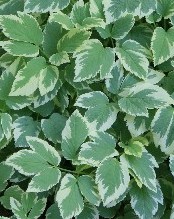 Also called goutweed, this herbaceous perennial is native to Eurasia but has been introduced into the US where it is often used as a ground cover. It is a member of the carrot family, Apiaceae, and related to parsley, dill, fennel and Queen Anne’s lace. Rhizomes produce erect, hollow, grooved stems eight to twelve inches tall and ivy-shaped leaves that quickly form dense mounds. The three inch long leaves have serrated margins and are light green in the center with cream variegation on the edges. The small cream colored flowers are produced in umbels on long slender stems well above the foliage from late spring to early summer. They can be used as cut flowers and are excellent for craft projects when dried and pressed, but are often removed in order to control the spread of the plant by seeds and/or to maintain the attractiveness of the plant as a ground cover. If the foliage becomes unattractive in the summer the plants can be mowed at a high setting to stimulate new growth. Although the foliage is very attractive the plant should be used only with extreme caution as it is very invasive if it likes the site and is difficult to control. The all-green form is even more aggressive. If the plant is used in the garden it should be contained to prevent unwanted spread. The plant was used to cure gout, hence the common name goutweed, and was thought to resemble a bishop’s mitre, leading to the common name bishop’s weed. The genus name Aegopodium, from the Greek words aix meaning goat, and podion, meaning a little foot. The specific epithet, podagraria, comes from Greek word podagra, meaning gout in the foot.
Also called goutweed, this herbaceous perennial is native to Eurasia but has been introduced into the US where it is often used as a ground cover. It is a member of the carrot family, Apiaceae, and related to parsley, dill, fennel and Queen Anne’s lace. Rhizomes produce erect, hollow, grooved stems eight to twelve inches tall and ivy-shaped leaves that quickly form dense mounds. The three inch long leaves have serrated margins and are light green in the center with cream variegation on the edges. The small cream colored flowers are produced in umbels on long slender stems well above the foliage from late spring to early summer. They can be used as cut flowers and are excellent for craft projects when dried and pressed, but are often removed in order to control the spread of the plant by seeds and/or to maintain the attractiveness of the plant as a ground cover. If the foliage becomes unattractive in the summer the plants can be mowed at a high setting to stimulate new growth. Although the foliage is very attractive the plant should be used only with extreme caution as it is very invasive if it likes the site and is difficult to control. The all-green form is even more aggressive. If the plant is used in the garden it should be contained to prevent unwanted spread. The plant was used to cure gout, hence the common name goutweed, and was thought to resemble a bishop’s mitre, leading to the common name bishop’s weed. The genus name Aegopodium, from the Greek words aix meaning goat, and podion, meaning a little foot. The specific epithet, podagraria, comes from Greek word podagra, meaning gout in the foot.
 Type: Herbaceous perennial
Type: Herbaceous perennial
Bloom: Small creamy-white flowers in umbels from late spring .to early summer
Size: 8-12″ H x spreading 12-18″ W
Light: Full sun to part shade but tolerates full shade
Soil: Average to lean, dry to moist, well-drained
Care: Plant with caution so that the rhizomes can not spread beyond the area allotted to it.
Hardiness: Zones 4-9
Pests and Diseases: None of significance
Propagation: Division in early spring or early fall, seed
Companion Plants: Ajuga reptans, daylily, pachysandra, ivy